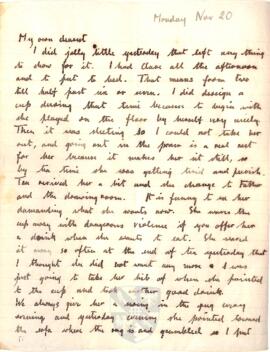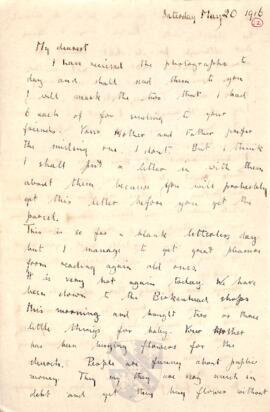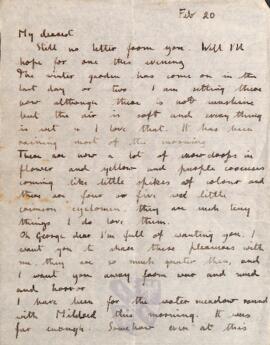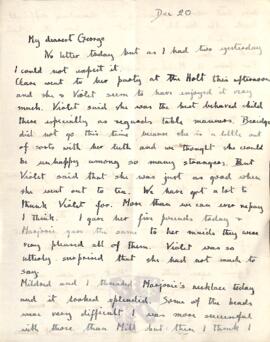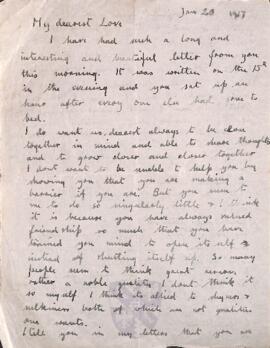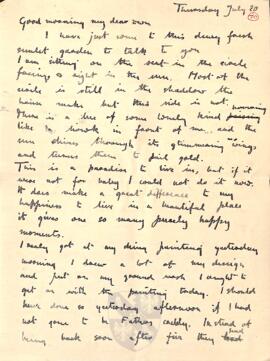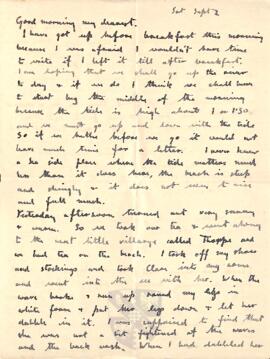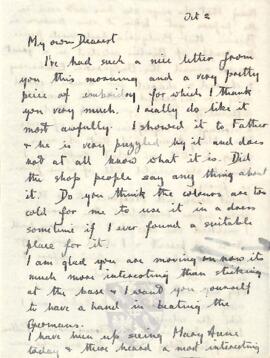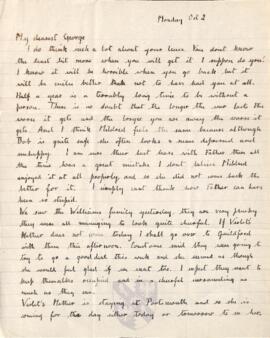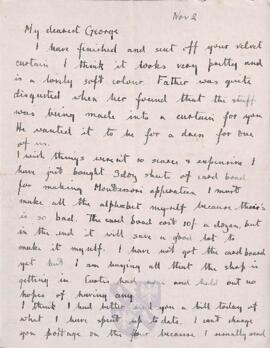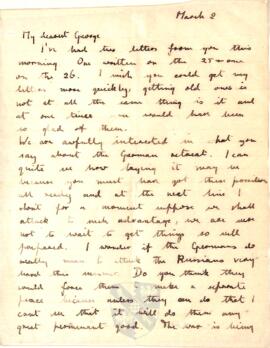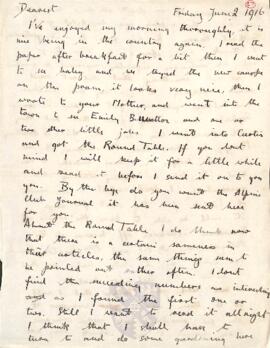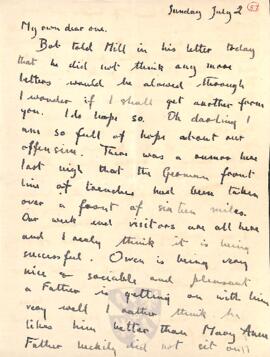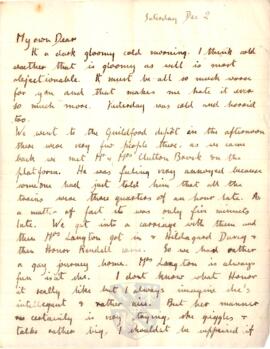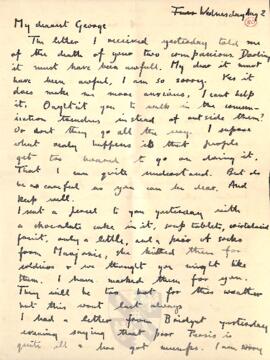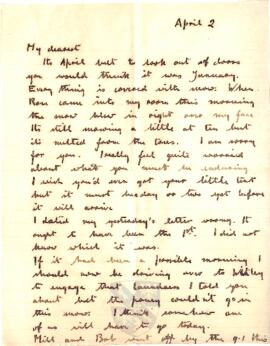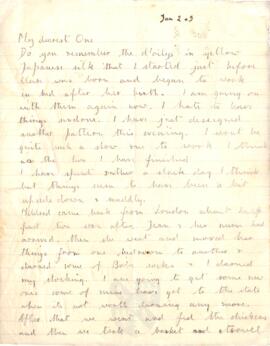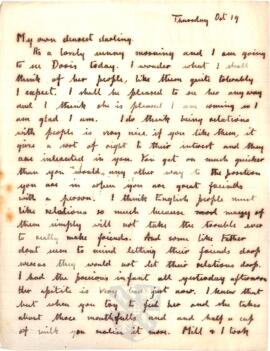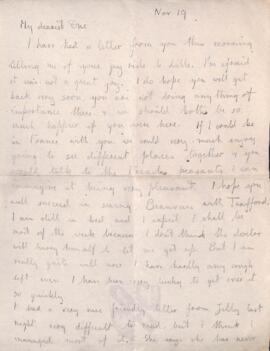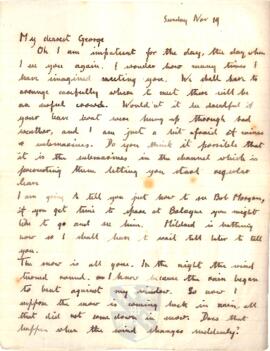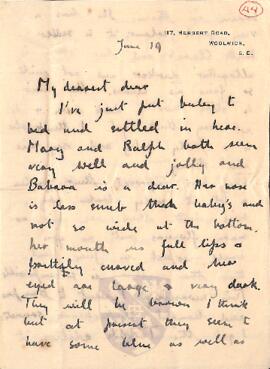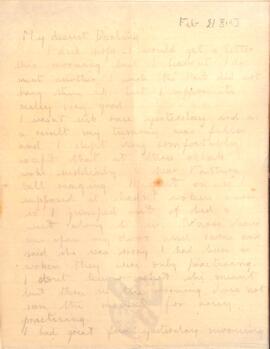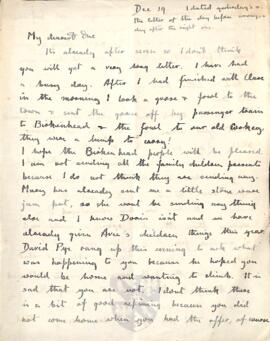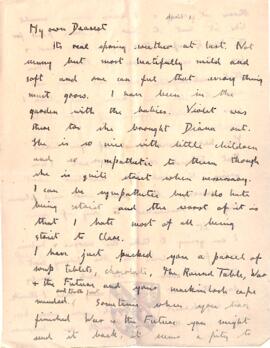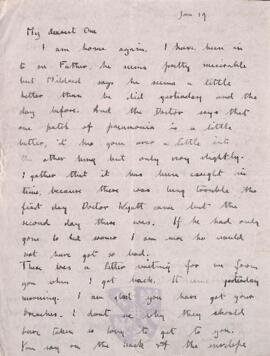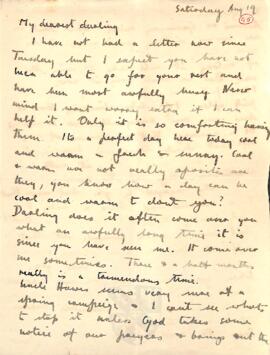Describes in detail Clare's eating habits. Tells him about visiting Dick Wimberly and hearing about his experiences on the Somme. Updates him on Violet's tooth trouble. Discusses the capture of Monastier and the progress of the war. Tells him about the book Anne Veronica she has finished and discusses the plot. Hopes he is well and expresses her wish for him to come home on leave.
She has received photographs and will send six of them to his friends. Describes her activities at Birkenhead with his mother. Discusses her opinions on public and private debt. Intends to visit Nancy Warr. Hopes that he does not feel frightened. Updates him on Clare's progress. Expresses how much she misses him and what she is doing to fill her time.
Discusses sending him cake, tea, and dried fruits. Updates him on Clare's progress. She has enjoyed her time with Mary and explains the friendship dynamics between Bridget, Ralph and Stephen. Discusses the progress of the war and the dangers of speculating on locations of loved ones. Expresses her wish to have a baby boy next time and tells him about Clare's character. Discusses her thoughts on life and death.
Describes the weather, the gardens, and the walks she has been going on with Mildred. Tells him about goose hunting in the canoe. Discusses how she prays for different people.
Tells him about Clare and Beridge attending a party at the Holt. Describes Violet's reaction to receiving her five pound bonus. Describes making a necklace for Marjorie. Asks him for reading suggestions and expresses what she would like to read. Tells him she would have liked to vote in his place. Asks him where in Calais is he located and expresses her fears of him being assigned another task that will keep him from coming home. Expresses her opinions about party politics. Discusses the nature of their friend's marriages and openness of their lives. Tells him she will always use the baby welfare group for doctor's advice because it is paid for by the rates. Sends him Christmas wishes.
Acknowledges his letter of the 15th and expresses her opinions about friendship and being open with each other. Discusses The Life of Christ. Asks him if he is moving position. Updates him on the health of her father. Asks him if he likes the knife she sent him. Discusses his opinions about Robinson.
Thursday 20 July - Describes her surroundings as she writes. Describes golfing with her father and Mr Raxworthy. Discusses Clare’s lack of musical talent, her progress and her education, including learning French at a young age.
Friday 21 July – Informs him she has sent his food parcels. Apologises for her carelessness with spelling. Informs him of the death of Mr Tompson, killed in action and wonders about the safety of Mr Willet. Asks him to inform her about how much danger he is in. Informs him about the premature birth of Mrs Irvine’s son. Expects a visit from Bridget. Discusses how the war has made them grow up. Is happy that he is keeping joyful.
Describes her intended activities. Describes paddling in the sea with Clare and Clare's reaction to the seaside. Tells him about Uncle Lawrence's plans to make toy stands for an arts and crafts exhibition and a model of a building that will be used to remember Colonials fallen in the war. Discusses the progress of the war.
Acknowledges his last letter and thanks him for the embroidery. Is glad he is now moving. Describes a piece of news Mary Anne told her about celebrations in Berlin regarding the peace with Bulgaria. Tells him about milking the cows with Marjorie and her new coat and skirt. Informs him that she has visited Flossy Carson and updates him on her health and on the unfortunate news that her baby is feared dead. Describes garden plans with Mary Anne. Discusses the progress of the war. Hopes that he has time to write. Tells him about reading a letter from Mr Lytton Strachey. Informs him she is reading about the French Revolution.
Expresses her longing to have him home on leave. Discusses the morale of the Williams family and intends to visit them. Informs him that Violet’s mother is staying. Describes catching a goose for the Clutton-Brocks. Describes her gardening plans. Discusses the progress of the war and how and when it will end. Describes a disagreement with Violet.
Informs him that the curtain is finished and being sent to him. Tells him about making the Montessori apparatus on a budget. Asks for his opinion on the peace terms. Describes how Clare likes to climb ladders. Expresses her opinion about his Alpine Journal article and asks him to send it back to her.
Expresses in detail her love for him. Discusses her thoughts on God’s relationship with humanity. Describes a story told to her by Robert Graves concerning his experiences with spiritualism. Tells him she tried to visit the girl in need again and was unsuccessful. Describes a design for a cup.
Acknowledges his letter's of 25 and 26 February. Discusses the progress of the war. Describes the weather. Tells him that Peggy Gregson and Dorothea Lockhart are coming to lunch. Discusses the book Diana of the Crossway. Asks him to tell her more about his General. Updates him on Clare's progress.
Describes her morning activities; writing to his mother, walking to town. Asks him if he wants the Alpine Club Journal. Discusses the book she is reading - The Round Table. Tells him Harry has left to join his regiment. Informs him that Violet has gone to Prior's Field for the day. Discusses how busy his parents are with the mission. Tells him she misses him and gives details of how she keeps busy.
Discusses the progress of the German trenches. Describes her father's relationship with Owen and Mary Anne. Describes the servants annoyance at having to move guests about the house. Talks about her domestic duties. Hopes that her letters will still get through to him. Discusses her feelings about soldiers being wounded and sent home. Is enjoying having Clare to herself. Wonders how domestic duties will be allocated when Marjorie leaves. Tells him she misses him.
Describes the weather and her journey home from the depot on the train. Tells him about a conversation with Will and Olive Kennedy about the French army. Updates him on Clare's progress.
Is sorry to hear of the death of his companions and urges him to stay safe. Describes the contents of the parcel she has sent him. Informs him that Bridget’s daughter has mumps and will not be visiting. Discusses the design of her bowl. Describes her train journey from Guildford. Discusses Mildred and her father’s organisation. Hopes he will have leave soon. Discusses the progress of the war. Tells him that Constance Mussen’s husband is in the field artillery. Is enclosing a dividend warrant for him to sign. Apologises that her letter has not been interesting and expresses her anxiety over his safety. Intends to be her father’s caddy at the golf course.
Is thankful for his letters. Describes watching the kittens playing and the weather. Hopes he is having a nice time. Complains that Agnes is not much of a cook. Tells him of her drive with Mildred to Shamley Green and of her wish for them to live there one day. Reminds him to send her his new address and informs him of a coming visit from Anna and Moresco Pierce. Is sorry that Mr Reade will not be joining him.
Describes the snowy weather. Updates him on Bob and Mildred's travels. Describes a visit to see Constance's new baby. Tells him about her morning plans. Hopes that he has shelter where he is located. Discusses the affects the weather is having on agriculture.
Tuesday 2 Jan. evening - Tells him about her day's activities running errands. Describes seeing dapple grey horses in the woods.
Wednesday 3 Jan. morning - Compares Clare's nature to Jean's. Asks him if people in France are feeling optimistic about the war. Expresses her concern for his safety.
Informs him she is visiting Doris and expresses her opinions about relations. Describes taking Clare out to the Brocks and making a smocked tunic. Discuss the progress of the war and when he will get leave. Expresses her love for him and her wish for the war to end.
Acknowledges his last letter. Updates him on her health. Tells him she has heard from Jelly and updates him on her news. Describes reading about the fight against the submarine warfare of the Germans. Updates him on Berry's progress. Tells him about the seriousness of the flu in Guildford and the deaths they have had there. Discusses the mutiny of the German navy.
Wishes for his leave to be arranged. Tells him about Violet’s meeting with her cousin and how Clare demands attention. Informs him that Alison is to stay. Asks him if he will go to visit Bob [Robert Morgan, his brother in law] in Boulogne. Tells him about Violet’s father being sent home. Informs him that Raymond may be visiting when he leaves hospital. Apologises for her letters being dull and uninteresting. Discusses their life after the war and her wish to have another baby.
Hopes that he is receiving her letters by now. Tells him she intends to send him some seeds to plant. Describes her trip in to Liverpool. Asks him how is getting along with Mr Bell and enquires after him. Asks him questions about the guns he is using. Hopes he is happy in his surroundings. His mother is sending him a picture from Punch magazine.
She has settled in with Mary and Ralph. Compares their baby, Barbara, with Clare. Describes Mary and Ralph's garden. Informs him she has purchased Shakespeare's Sonnets in the Temple edition. Intends to cut her trip short and head back to Westbrook. Expresses her admiration for Bridget. Discusses the meanings of Shakespeare's sonnets. Is looking forward to him coming home on leave.
Discusses the post and hopes to get a letter from him soon. Describes an incident in the night between her father and the nurse practising with ringing the bell. Describes in detail a walk to Eashing bridge with Marjorie. Describes the china that has come back and how pleased she is with it. Tells him about Mildred's worries for Bob and how they are all tired of the war. Expresses her happiness to hear of the advance at Ancre.
Discusses Christmas arrangements. Tells him David Pye has been asking after him. Discusses the arrangements for the nursery at the Holt. Asks him to see a doctor about his headaches and is glad to hear his ankle is fully healed. Expresses her opinions about Stephen Tallent's book.
Describes the weather and Violet's relationship with children. Tells him what she has sent in his parcel an asks him to tell her what he thinks of the new items. Reflects on past times together. Expresses her opinions about the Ottoman empire and different types of punishment. Expresses her wish for him to be home.
Tells him she is back home and updates him on her fathers health. Acknowledges his last letter and asks about the parcels she has sent. Discusses the progress of the war. Describes a letter from his mother requesting she stay at Buxton with her. Hopes she will get another letter from him soon.
Describes the weather and expresses her fear of not hearing from him for a few days. Remarks on how long it has been since they saw each other. Discusses the progress of the war. Describes climbing a tree and expresses her opinion on how married women are expected to behave. Tells him Susan the maid is leaving and they will have to make their own beds. Describes the bowl she is working on. Expresses her opinions on Mrs Green's character. Discusses her plans for the garden. Discusses the German failure at Verdun.
